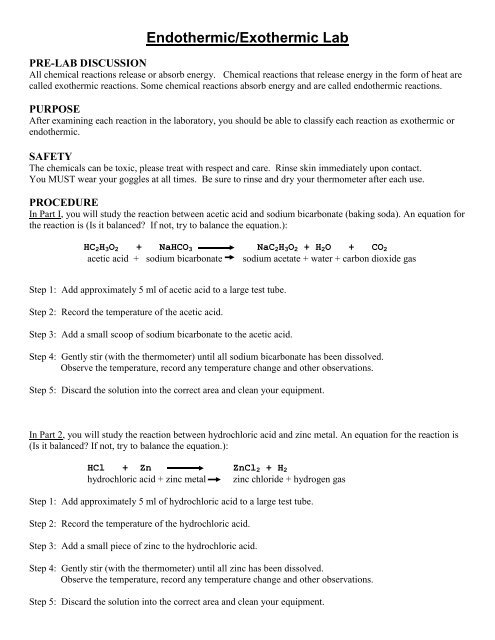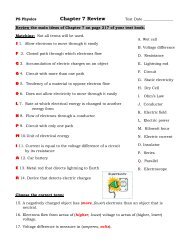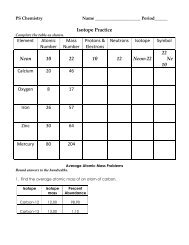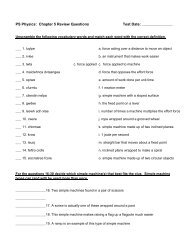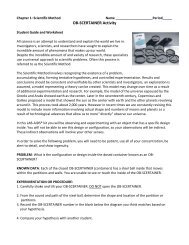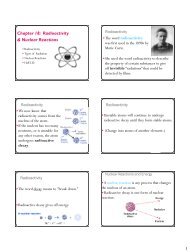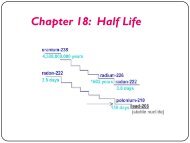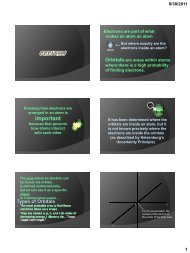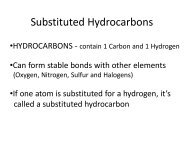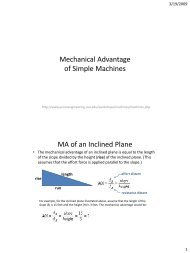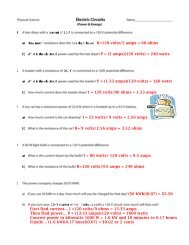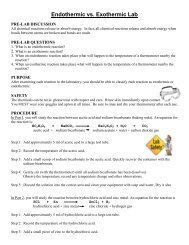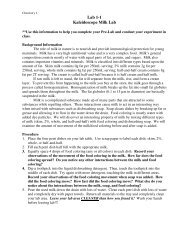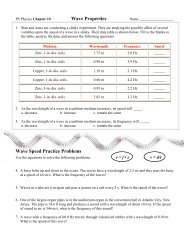Endothermic/Exothermic Lab
Endothermic/Exothermic Lab
Endothermic/Exothermic Lab
Create successful ePaper yourself
Turn your PDF publications into a flip-book with our unique Google optimized e-Paper software.
<strong>Endothermic</strong>/<strong>Exothermic</strong> <strong>Lab</strong><br />
PRE-LAB DISCUSSION<br />
All chemical reactions release or absorb energy. Chemical reactions that release energy in the form of heat are<br />
called exothermic reactions. Some chemical reactions absorb energy and are called endothermic reactions.<br />
PURPOSE<br />
After examining each reaction in the laboratory, you should be able to classify each reaction as exothermic or<br />
endothermic.<br />
SAFETY<br />
The chemicals can be toxic, please treat with respect and care. Rinse skin immediately upon contact.<br />
You MUST wear your goggles at all times. Be sure to rinse and dry your thermometer after each use.<br />
PROCEDURE<br />
In Part I, you will study the reaction between acetic acid and sodium bicarbonate (baking soda). An equation for<br />
the reaction is (Is it balanced? If not, try to balance the equation.):<br />
HC 2 H 3 O 2 + NaHCO 3 NaC 2 H 3 O 2 + H 2 O + CO 2<br />
acetic acid + sodium bicarbonate sodium acetate + water + carbon dioxide gas<br />
Step 1: Add approximately 5 ml of acetic acid to a large test tube.<br />
Step 2: Record the temperature of the acetic acid.<br />
Step 3: Add a small scoop of sodium bicarbonate to the acetic acid.<br />
Step 4: Gently stir (with the thermometer) until all sodium bicarbonate has been dissolved.<br />
Observe the temperature, record any temperature change and other observations.<br />
Step 5: Discard the solution into the correct area and clean your equipment.<br />
In Part 2, you will study the reaction between hydrochloric acid and zinc metal. An equation for the reaction is<br />
(Is it balanced? If not, try to balance the equation.):<br />
HCl + Zn ZnCl 2 + H 2<br />
hydrochloric acid + zinc metal zinc chloride + hydrogen gas<br />
Step 1: Add approximately 5 ml of hydrochloric acid to a large test tube.<br />
Step 2: Record the temperature of the hydrochloric acid.<br />
Step 3: Add a small piece of zinc to the hydrochloric acid.<br />
Step 4: Gently stir (with the thermometer) until all zinc has been dissolved.<br />
Observe the temperature, record any temperature change and other observations.<br />
Step 5: Discard the solution into the correct area and clean your equipment.
In Part 3, you will study the reaction between magnesium sulfate (Epsom salt) and water. An equation for the<br />
reaction is (Is it balanced? If not, try to balance the equation.):<br />
MgSO 4 + H 2 O MgSO 4 + H 2 + O 2<br />
magnesium sulfate + water hydrogen gas + oxygen gas<br />
Step 1: Add approximately 10 ml of water to a large test tube.<br />
Step 2: Record the temperature of the water.<br />
Step 3: Add a small scoop of magnesium sulfate to the water.<br />
Step 4: Gently stir (with the thermometer) until all magnesium sulfate has been dissolved.<br />
Observe the temperature, record any temperature change and other observations.<br />
Step 5: Discard the solution into the correct area and clean your equipment.<br />
In Part 4, you will study the reaction between calcium chloride and water. An equation for the reaction is (Is it<br />
balanced? If not, try to balance the equation.):<br />
CaCl 2 + H 2 O CaCl 2 + H 2 + O 2<br />
calcium chloride + water calcium chloride + oxygen gas<br />
Step 1: Add approximately 10 ml of water to a large test tube.<br />
Step 2: Record the temperature of the water<br />
Step 3: Add a small piece(s) of calcium chloride to the water.<br />
Step 4: Gently stir (with the thermometer) until all calcium chloride has been dissolved.<br />
Observe the temperature, record any temperature change and other observations.<br />
Step 5: Discard the solution into the correct area and clean your equipment.
<strong>Endothermic</strong>/<strong>Exothermic</strong> <strong>Lab</strong><br />
OBSERVATIONS<br />
Name(s):<br />
Part 1: Initial temperature of acetic acid __________<br />
Temperature after adding sodium bicarbonate to the acetic acid__________<br />
Did you feel a temperature change? __________<br />
What did you observe during the reaction?<br />
Part 2: Initial temperature of hydrochloric acid__________<br />
Temperature after adding zinc metal to the hydrochloric acid__________<br />
Did you feel a temperature change? __________<br />
What did you observe during the reaction?<br />
Part 3: Initial temperature of water__________<br />
Temperature after adding magnesium sulfate to the water__________<br />
Did you feel a temperature change? __________<br />
What did you observe during the reaction?<br />
Part 4: Initial temperature of water__________<br />
Temperature after adding calcium chloride to the water__________<br />
Did you feel a temperature change? __________<br />
What did you observe during the reaction?<br />
ANALYSIS<br />
Part 1: The reaction of sodium bicarbonate and acetic acid is exothermic or endothermic? What evidence do<br />
you have?
Part 2: The reaction of zinc metal and hydrochloric acid is exothermic or endothermic? What evidence do you<br />
have?<br />
Part 3: The reaction of magnesium sulfate and water is exothermic or endothermic? What evidence do you<br />
have?<br />
Part 4: The reaction of calcium chloride and water is exothermic or endothermic? What evidence do you have?<br />
Calcium chloride is as an ice-melting compound on sidewalks and city streets. Explain what is happening (use<br />
one of the terms-exothermic or endothermic in your explanation).<br />
Does the energy go from the surrounding to the chemicals or from the chemicals to the surroundings in an exothermic<br />
reaction?<br />
GOING FURTHER<br />
Define endothermic and exothermic in your own words.<br />
Classify each of the following as an exothermic or endothermic process.<br />
Melting ice cubes _____________________<br />
Burning a candle ____________________<br />
Evaporation of water____________________<br />
Baking Bread _____________________<br />
Splitting a gas molecule apart ___________________<br />
Formation of snow in clouds ____________________<br />
Part 1: Balanced equation… HC 2 H 3 O 2 + NaHCO 3 NaC 2 H 3 O 2 + H 2 O + CO 2<br />
Part 2: Balanced equation… HCl + Zn ZnCl 2 + H 2<br />
Part 3: Balanced equation… MgSO 4 + H 2 O MgSO 4 + H 2 + O 2<br />
Part 4: Balanced equation… CaCl 2 + H 2 O CaCl 2 + H 2 + O 2


